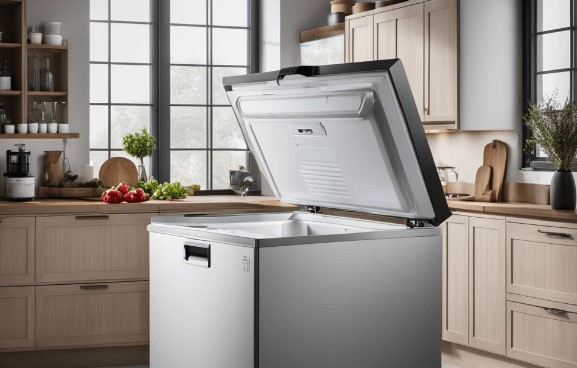Keeping your chest fridge freezer in good shape helps food stay safe, saves energy, and keeps it working for years. Whether you use one at home or take care of supermarket freezers, looking after them helps avoid big problems. This will show fun and easy ways to take care of your freezer.
Why Regular Maintenance Matters
When you take care of your chest fridge freezer, it stays strong and cools better. It keeps food safe, uses less energy, and doesn’t break down.
If you work with supermarket freezers, taking care of them means lower power bills, fewer repairs, and less spoiled food.
If you don’t look after it, you might see:
- Thick frost is building up.
- Loud or tired-sounding motors.
- Broken or torn lid seals.
- Higher electricity bills.
- A freezer that wears out too fast
Ignore small problems, they grow bigger. But if you tackle them early, your freezer stays happy and healthy.
Interior Cleaning Tips
Melt Away the Frost
Frost builds up and takes up space. It also makes the freezer work harder. Melt the frost every 3 to 6 months or when it’s thicker than 5mm.
To melt frost:
- Switch off and unplug the freezer.
- Move food to a cooler or another freezer.
- Leave the lid open and let the ice melt by itself.
- Put towels or trays to catch the drips.
- Don’t poke or scrape the ice with sharp things
Scrub the Inside
After the ice melts, clean the inside with warm water and a small amount of soap. Don’t use strong cleaners. Rinse well and dry before you plug it back in.
Exterior Maintenance
Brush Off the Coils
The coils at the back or bottom blow out heat. Dust sticks to them and makes the freezer work harder. Clean them every 4 to 6 months.
To clean the coils:
- Unplug the freezer.
- Find the coils.
- Gently brush off the dust or vacuum it.
- Wipe around the area if it’s dirty.
Test the Lid Seal
The seal around the lid keeps cold air in. If it breaks, cold air leaks out, and frost grows faster.
To test the seal:
- Close the lid on a piece of paper.
- Try to pull the paper—if it slides out, fix or change the seal.
- Wipe the rubber seal often with warm water.
- Don’t use harsh cleaners on it.
Organising Your Freezer
Don’t Cram It
Freezers work better when they’re at least half full. But stuffing them with too many blocks blocks the air. Make sure air can move around the food.
Group and Label
Put similar foods together in baskets or bins. Write dates and names on containers. This helps you find things quickly. In supermarket freezers, this also saves time and keeps the lid shut longer.
Swap Old for New
Use older food first. Put new food at the bottom and bring older food to the top. This keeps everything fresh and tidy.
Temperature and Power Settings
Pick the Right Chill
Your freezer should stay at -18°C. Check it with a freezer thermometer each week. Hot weather can change the inside temperature.
If the temperature is wrong, you might notice:
- Food that’s soft or soggy.
- Ice on food or weird white marks.
- A motor that doesn’t stop humming.
Plug It Right
Plug your freezer into a wall socket. Don’t use long extension cords—they can overheat. Check the plug and cord for damage and swap them if they look worn.
Keep Checking Your Freezer
Look at your freezer each month to stop small issues from growing.
Here’s what to check:
- Strange sounds like buzzing or clicking.
- Water under the freezer.
- A lid that doesn’t shut tightly.
- The light or display is not working.
Fixing small problems early keeps your freezer running longer.
Best Spot for Your Freezer
Where you place the freezer matters. It needs room to breathe and a calm spot.
Place your freezer:
- In a cool, dry room with fresh air
- Far from ovens or sunlight
- On a flat surface, so the lid shuts properly
In stores, supermarket freezers need space around them. This helps air move and makes cleaning easier. Tight spots cause stress on the machine.
Handy Tips for a Happy Freezer
Follow these extra tips to help your freezer last:
- Don’t hold the lid open too long
- Keep the freezer half full at least.
- Use a surge plug to stop damage from power spikes.
- Wipe spills quickly to stop the smell.s
- Read the guidebook that comes with the freezer.
Care for it, your chest fridge freezer can work well for over 10 years. Whether it’s in your garage or a row of supermarket freezers, these simple steps keep things cool and running strong.
Final thought
Taking care of your chest fridge freezer doesn’t have to be hard. When you follow these simple tips—like cleaning, defrosting, and checking the temperature—you help your freezer last longer and work better. Good habits save money, keep your food fresh, and stop big problems before they start.
Whether it’s in your home or a busy store with supermarket freezers, regular care makes a big difference. A clean and well-organised freezer is not only easier to use but also much safer for food storage. Stick with these steps, and your freezer will stay reliable for many years to come.
Frequently Asked Questions (FAQ)
1. How Often Should I Melt the Frost?
Every 3 to 6 months, or when frost gets thicker than 5mm. Melting the frost helps your freezer stay cool and clean.
2. Why Does My Freezer Make Noise?
The coils might be dusty, or the fan might be stuck. Clean the coils and make sure nothing blocks the air.
3. Can I Keep My Freezer in the Garage?
Yes, if it stays cool and dry. Hot garages can mess with the freezer’s job.
4. How Can I Tell If the Seal Is Bad?
Try the paper test—if you can slide the paper out, the seal isn’t tight. You should clean or replace it.
5. What Temperature Is Best?
Keep it at -18°C. Use a freezer thermometer and check it every week.


